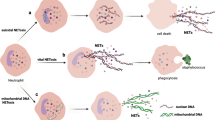Abstract
One of the most important clinical problems in caring for elderly patients is treatment of pressure ulcers. One component of normal wound healing is the generation of an inflammatory reaction, which is characterized by the sequential infiltration of neutrophils, macrophages and lymphocytes. Neutrophils migrate early in the wound healing process. In aged C57BL/6 mice, wound healing is relatively inefficient. We examined the effects of neutrophil numbers on wound healing in both young and aged mice. We found that the depletion of neutrophils by anti-Gr-1 antibody dramatically delayed wound healing in aged mice. The depletion of neutrophils in young mice had less effect on the kinetics of wound healing. Intravenous G-CSF injection increased the migration of neutrophils to the wound site. While the rate of wound repair did not change significantly in young mice following G-CSF injection, it increased significantly in old mice.





Similar content being viewed by others
Reference
Ashcroft GS, Mills SJ, Ashworth JJ (2002) Ageing and wound healing. Biogerontology Rev 3(6):337–345
Ballas CB, Davidson JM (2001) Delayed wound healing in aged rats is associated with increased collagen gel remodeling and contraction by skin fibroblasts, not with differences in apoptotic or myofibroblast cell populations. Wound Repair Regen 9(3):223–237
Bourke E, Cassetti A, Villa A, Fadlon E, Colotta F, Mantovani A (2003) IL-1 beta scavenging by the type II IL-1 decoy receptor in human neutrophils. J Immunol 170(12):5999–6005
Cohen BJ, Cutler RG, Roth GS (1987) Accelerated wound repair in old deer mice (Peromyscus maniculatus) and white-footed mice (Peromyscus leucopus). J Gerontol 42(3):302–307
Danon D, Kowatch MA, Roth GS (1989) Promotion of wound repair in old mice by local injection of macrophages. Proc Natl Acad Sci USA 86(6):2018–2020
Dovi JV, He LK, DiPietro LA (2003) Accelerated wound closure in neutrophil-depleted mice. J Leukoc Biol 73:448–455
Fulop T, Larbi A, Douziech N, Fortin CF, Guerard KP, Lesur O, Khalil A, Dupuis G (2004) Signal transduction and functional changes in neutrophils with aging. Aging Cell 3:217–226
Grove GL, Kligman AM (1983) Age-associated changes in human epidermal cell renewal. J Gerontol 38:137–142
Hellemans L, Corstjens H, Neven A, Declercq L, Maes D (2003) Antioxidant enzyme activity in human stratum corneum shows seasonal variation with an age-dependent recovery. J Invest Dermatol 120:434–439
Hubner G, Brauchle M, Smola H, Madlener M, Fassler R, Werner S (1996) Differential regulation of pro-inflammatory cytokines during wound healing in normal and glucocorticoid-treated mice. Cytokine 8(7):548–556
Larbi A, Douziech N, Fortin CF, Linteau A, Dupuis G, Fulop T (2005) The role of the MAPK pathway alterations in GM-CSF modulated human neutrophil apoptosis with aging. Immun Ageing 2(1):6
Leibovich SJ, Ross R (1975) The role of the macrophage in wound repair. A study with hydrocortisone and antimacrophage serum. Am J Pathol 78(1):71–100
Leibovich SJ, Ross R (1976) A macrophage-dependent factor that stimulates the proliferation of fibroblasts in vitro. Am J Pathol 84(3):501–514
Martin P (1997) Wound healing-aiming for perfect skin regeneration. Sci Rev 276(5309):75–81
Ross R, Benditt EP (1962a) Wound healing and collagen formation. II. Fine structure inexperimental scurvy. J Cell Biol 12:533–551
Ross R, Benditt EP (1962b) Wound healing and collagen formation. III. A quantitative radioautographic study of the utilization of proline-H3 in wounds from normal and scorbutic guinea pigs. J Cell Biol 15:99–108
Schroder AK, von der Ohe M, Kolling U, Altstaedt J, Uciechowski P, Fleischer D, Dalhoff K, Ju X, Zenke M, Heussen N, Rink L (2006) Polymorphonuclear leucocytes selectively produce anti-inflammatory interleukin-1 receptor antagonist and chemokines, but fail to produce pro-inflammatory mediators. Immunology 119(3):317–327
Simpson DM, Ross R (1972) The neutrophilic leukocyte in wound repair a study with antineutrophil serum. J Clin Invest 51(8):2009–2023
Swift ME, Burn AL, Gray KL, DiPietro LA (2001) Age-related alterations in the inflammatory response to dermal injury. J Invest Dermatol 117(5):1027–1035
Yuli I, Tomonaga A, Synderman R (1982) Chemoattractant receptor functions in human polymorphonuclear leukocytes are divergently altered by membrane fluidizers. Proc Natl Acad Sci USA 79(19):5906–5910
Acknowledgements
This work was supported by grants from the Ministry of Health, Labor, and Welfare of Japan.
Author information
Authors and Affiliations
Corresponding author
About this article
Cite this article
Nishio, N., Okawa, Y., Sakurai, H. et al. Neutrophil depletion delays wound repair in aged mice. AGE 30, 11–19 (2008). https://doi.org/10.1007/s11357-007-9043-y
Received:
Accepted:
Published:
Issue Date:
DOI: https://doi.org/10.1007/s11357-007-9043-y




